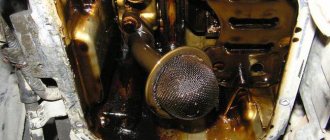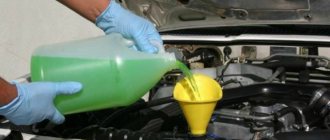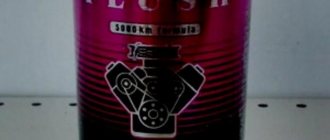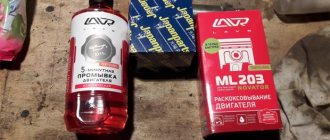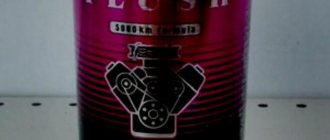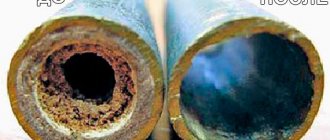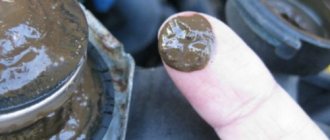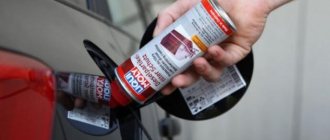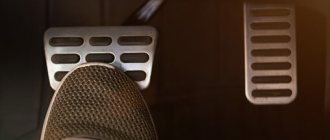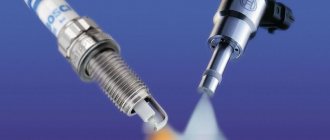There are fewer and fewer carburetor cars every year. Leading automakers have long switched to the injection type, which has a lot of advantages. This means lower fuel consumption, increased performance, a more balanced fuel-air mixture, etc. However, problems have also arisen. The injector is more expensive to repair; in addition, its injectors often become clogged, for which the “Lavr” product is often used to clean them. This flushing has its pros and cons, which we will talk about in this article.
Why does a car injector get clogged and how to deal with it?
Most chemical compounds found in fuel, such as sulfur, olefin and benzene, form tar deposits in the vehicle's fuel system. They cannot be removed with gasoline, as they are covered with a dense brown crust. The lower quality fuel is used, the more such deposits accumulate in the car over time.
It is quite logical that the overall efficiency of the car decreases, as the injectors become dirty. Due to the fact that complex injector flushing is a rather labor-intensive procedure, many people drive like this until a critical moment comes. The car will start to stall, the engine will run unstably, and some mornings you may not even start. To prevent this from happening, a liquid called “Laurel” is used. In this case, flushing the injector comes down to a few simple manipulations, which we will talk about in this article. It is also necessary to touch upon the engine cooling system.
How often to change the oil
As a rule, car manufacturers recommend a replacement interval of 10,000 km. This mileage is indicated in the technical documents of the vehicle. These regulations should be observed if you rarely get stuck in traffic jams, use high-quality fuel, and prefer a calm driving style. For most cars, it is recommended to change the engine oil more frequently, at least once every 7,500 km.
Here is a list of circumstances that shorten service life and require more frequent oil changes:
- The power plant often operates at high speeds.
- The car is stuck in traffic jams every day. This point is relevant for all major cities.
- Low quality fuel is used.
- The car travels short distances. Less than 30 minutes pass from starting the engine to stopping.
- The car often drives on dirt or dusty roads.
If at least one of the circumstances is familiar to you, you need to change the oil more often than required by the car’s service book.
Active additives - good or bad?
There are a large number of both supporters of chemically active components and those who categorically refuse to use them. Both the first and second are based on life experience, technical knowledge or simply expert advice.
First, you need to understand how flushing works on car systems. Let's highlight the main strengths and weaknesses:
- chemically active components, which can be called aggressive, have a negative effect on all rubber gaskets and seals. This leads to their accelerated wear;
- if the viscosity of the additive does not correspond to the viscosity of the oil, then its use is strictly prohibited, as indicated by the manufacturer on the packaging with flushing;
- Low-quality products for removing oil deposits only make things worse (they clog the catalytic converter, spark plugs), resulting in more problems than they are worth.
That is why not every car owner is satisfied with the result.
Allowable oil consumption
For some engines, oil consumption is a common occurrence, and automakers know about it. That is the normal state of other units, when between replacements the level does not drop even a millimeter. As a rule, the technical documentation contains information about the permissible oil consumption for a specific engine. Before making a diagnosis yourself, read more about the engine; perhaps your fears about the condition of the engine will be in vain.
However, if the engine begins to show an excessive appetite, and from replacement to replacement you add more than 1 liter of lubricant, there is reason to think about the condition of the cylinder-piston group and conduct professional engine diagnostics.
Why it's better not to experiment
Many people try to carry out various experiments with washings, which in most cases end sadly. For example, the concentration of the rinse is changed. There is no need to do this, since almost the entire point of using the product is lost. It does not give the desired result, but the money is wasted.
In addition, you should not fill in more than necessary, especially if there is little gasoline in the tank. This can lead to the fact that you simply won’t get to the gas station without incident. For example, soft washing “Lavr” at a high concentration has an extremely negative effect on rubber seals, which can subsequently result in replacing gaskets and seals, which is costly.
“Lavr” product: flushing the injector and engine
If you notice jerking in your car when driving, unstable engine operation, problems with starting in the cold season, then it’s time to use detergent additives.
All the work is quite easy to do yourself. To do this, a special product is poured into the gas tank every 5-6 thousand kilometers. True, such an event is carried out more as a preventative measure than as a “treatment”. Nevertheless, even owners of new cars need to do this regularly. As for “Laurel,” it is used somewhat differently.
Sequence of actions when washing
First of all, we need “Laurel” - a soft engine flush. It is also advisable to have several liters of gasoline and a special watering can for filling. In the proportions indicated on the can, mix “Laurel” and gasoline, after which we find the tube going from the vacuum pump to the intake manifold, disconnect it and inject the mixture there.
It is necessary to start the engine and keep the speed within 2,500 thousand. At the same time, constantly add liquid to the tube. During this time, the engine will be unstable, but this is normal. Carbon deposits and large amounts of smoke may come out of the exhaust pipe. The exhaust at this time will be extremely toxic, so it is better for them not to breathe. We turn off the engine and let it cool, after which it is advisable to replace the spark plugs with new ones if they are no longer fresh. If the spark plugs are new, it is better to use old ones while washing them, as they are very likely to become coked.
Brief history
In Russia. The first indirect evidence that the engine needs flushing is the very fact that such liquids appeared in the late 1960s and early 1970s simultaneously in the USSR and the West. In the Soviet Union, internal combustion engine flushing was invented to clean low-speed diesel locomotive engines, and the product for this procedure itself was mineral oil, which was equipped with enhanced detergent additives. The cleaning process was quite long - more than 30 minutes. Then this method was transferred to passenger vehicles without any changes - they began to produce flushing oils, which were then sold very successfully.
But this method had significant drawbacks:
- Quite a lot of non-draining oil residues from the flushing oil settled inside the engine;
- Manufacturers skimped on the components of the composition, because the products posed a danger to highly accelerated engines.
In the West. Western companies have chosen a different path. Economists considered the use of oil products for flushing unprofitable: they had to pay twice - for the oil, and also for its disposal. Therefore, they developed a special technology for using flushing liquids, the descendants of which we know today as express flushes.
About the manufacturers of washes
One of the most popular liquids with the largest number of positive reviews is “Lavr”. This manufacturer has proven itself to be the best. This liquid must not be poured into the tank, as indicated on the label. According to owner reviews, the average rating for the liquid is 4 out of five. Many people say that you shouldn’t expect a miracle, but the product copes with its immediate task as it should.
Another popular one. Its cost is approximately the same as that of “Lavr” (a little more expensive, but not significant). As for the ratings, it’s also 4/5. True, experts say it is no worse than Winx, but less harmful to health. A product like High Gear is expensive, but it also cleans somewhat better. Well, now let's return directly to our topic.
What kind of Hi-Gear soft flush is it for a car engine or reviews about it
Why is this composition called “soft”? It's simple - the additive package in mineral oil is selected in a way that is beneficial for the engine. Unlike express washes, the concentration of aggressive components is lower here, and they work for a long time. In addition, the composition from an American company does not destroy rubber elements - this has been proven by experiments.
About the effect of Hi-Gear soft engine flushing, the reviews are unanimous – positive. For example, here is what Oleg N. from Novosibirsk writes:
“After sitting for a long time, my Subaru Outback suddenly started smoking. I filled up High Gear, but decided not to drive, but to “roll out” 200 km in engine hours. As a result, the car stood for 4 hours, idling. There was much less smoke. And after 50 km of running on the new oil, everything returned to normal.”
Much has been said about the effectiveness of the cleaning product. It is worth noting that this is the most successful deoxidizer of bitumen and oily deposits. His credit is that he does his job slowly. This means that malignant products will dissolve into small substances, mix with oil and, without clogging the meshes and small channels, come out as waste. This is confirmed by Nikolay M. from Tula, who has tried almost the entire Hi-Gear washing line. He formulated his review briefly:
- a soft drug is an effective and harmless thing;
- five or ten minutes - they wash, but clog the entire oil system with sludge;
- Flushing oils clean, but significantly damage camshafts and camshafts.
Composition of flushing additives
To understand whether it is harmful for a car to use this kind of cleaning or not, you need to understand the components that wash the engine and injectors from carbon deposits. The main component is kerosene. It is an excellent cleaner for oil stains. For greater efficiency, chemically active detergents are added, which make it possible to almost completely remove oil deposits on the nozzle channels.
About the car cooling system
When antifreeze turns an abnormal color, usually bright orange, there is rust in the system. In this case, it is necessary to flush the radiator and all channels. You can do this either independently or at a service station. “Lavr” is suitable as the main remedy. Flushing the cooling system will take quite a long time, since in case of severe contamination the situation will not be improved in one approach.
The first step is to drain the old antifreeze from the system. Next, take “Laurel” and fill one jar, then add distilled water to the minimum. We start the engine and let it run for about half an hour. After that, we drain it and see that there is a lot of rust in the pipes and radiators. It is advisable to repeat the procedure again in the same order. If rust still stands out, then at the third stage we simply use distillate, without rinsing. After the above procedures, fill in fresh antifreeze and enjoy the result.
Regular maintenance is the key to success
We have already figured out a little about what functions “Lavr” performs. Flushing the cooling system, injectors and engine - all this can be done with this product. However, do not forget that to achieve maximum results it is necessary to carry out regular maintenance.
For example, after cleaning the injectors they become dirty again, no matter how sad that may be. As a result, the situation repeats itself. To prevent this from happening, it is necessary to periodically use detergent additives, but not too often. When replacing antifreeze, which is done once every 12-24 months, it is advisable to flush the system as a preventive measure. In the same way, when replacing spark plugs with new ones, you can clean the injectors and the fuel system as a whole. It definitely won’t be superfluous, but you can sleep peacefully.
LAVR Motor Flush Soft 200 km – detergent additive for oil
STATED FEATURES
The detergent additive LAVR Motor Flush Soft 200 km (LAVR soft flushing) is poured into the engine oil system 150–200 kilometers before changing the oil. One package of the drug is designed to flush the oil system of an engine with a volume of 4–6 liters. According to the manufacturer, the additive most carefully removes varnish, bitumen and grease-like deposits in the engine oil system. At the same time, thanks to dispersants, it protects the engine from premature wear and prevents clogging of channels and filters. The additive rejuvenates rubber seals and gaskets and is compatible with all types of motor oils.
APPLICATION FEATURES
Before using a detergent additive in LAVR Motor Flush Soft 200 km oil, it is necessary to warm up the engine to operating temperature. After this, pour the additive into the oil filler neck and start the engine. Let it idle for 5 minutes, then start driving the car. After 150–200 kilometers, replace the oil filter and add new oil.
TEST RESULTS
Laboratory research has shown that the additive in LAVR Motor Flush Soft 200 km oil contains trace elements: calcium Ca - 24 mg/kg, magnesium Mg - 0 mg/kg, boron B - 1 mg/kg, zinc Zn - 10 mg/kg and phosphorus P – 12 mg/kg.
The additive in LAVR Motor Flush Soft 200 km oil contained only traces of additive elements, but not the additives themselves. From the obtained result we can conclude that this is an organic solvent, and it is advisable to drive 150–200 km after adding it to the engine at idle speed.
“Laurel”: flushing the cooling system. Consumer Reviews
The most reliable way to ensure the quality of a product is to test it for yourself. However, this approach often leads to dire consequences. For this simple reason, before using flushing, you need to look at what car enthusiasts or service station specialists write about it.
As for “Lavr”, today it is one of the most popular means in Russia along with “High Gear” and “Winx”. Flushing, according to reviews, has excellent cleaning properties and is not too aggressive towards rubber seals, although it has a negative effect on them.
How does flushing work?
Quick (five-minute) flushing of the engine lubrication system works using a fairly simple method. This composition is poured into the lubrication system, after which the engine should run for about 5 - 10 minutes, and the liquid resulting from mixing is drained. The composition of the product for flushing into the oil before changing includes a large (so-called shock) dose of detergent components. Which in a short time can wash away old dirt, scale, deposits and other debris. This is evidenced by numerous engine flush tests. Their results can be found in sufficient quantities on forums and various resources on the Internet.
Sometimes on the Internet you can find conflicting reviews about a particular product, the essence of which boils down to a negative effect. However, this attitude is often the result of improper application of flushing. If the product contains aggressive substances, then with prolonged exposure to rubber seals there is a risk of damage to the latter. And this leads to an emergency situation. Therefore, before using this or that product, you must carefully read the instructions for its use and act in accordance with it.
Looking ahead, it is worth noting that the effect of using such rinses is indeed observed, but it is not as fantastic as their manufacturers write in the instructions. Therefore, the appropriateness of use remains questionable.
Injector contamination level
As practice shows, not every car owner maintains his car on time. This usually leads to even more serious consequences. An example is injectors. They are responsible for uniform injection of the fuel-air mixture into the cylinder. Over time, both the cylinder and the injectors become coated with carbon deposits, resulting in reduced engine performance. Experts distinguish three degrees of injector contamination:
- 5-7% - almost imperceptible to the driver, since there are no signs of malfunction. Fuel consumption increases slightly.
- 10-15% - twitching is noticeable while driving, a drop in dynamic characteristics, and fuel consumption increases.
- 15-30% is a critical level. Gasoline consumption increases significantly, the engine sputters at idle, and most often stalls when cold.
Based on the above points, we can conclude that the first stage is not so critical, in addition, only an experienced specialist can detect the malfunction. But the lack of action on the part of the driver leads to the second, and accordingly, the final stage. Here the situation is more serious and requires special attention.
How to decarbonize an engine with your own hands?
It is important to know
The manufacturer indicates that the user must pour 45 ml of the product into one cylinder of the power unit. Accordingly, a concentrate of 185 ml will be sufficient for a standard motor. Non-standard power units (V-shaped, opposed, with a recess on the piston) will require a 330 ml bottle.
The formula will allow you to more accurately calculate the volume
Formula for calculating the volume of Laurel liquid for refilling
Total V ml202 =
Formula elements:
- D is the diameter of the motor piston, measured in centimeters;
- π is the number pi, which is 3.14;
- h liquid - the volume of the product, measured in centimeters above the surface of the piston.
If the power unit is characterized by a vertical arrangement of the cylinders, the height level can be about 1 cm. If the piston bottom has shaped recesses for the valves and combustion chamber, a small margin can be added.
Nuances regarding safety precautions and engine preparation:
- It is recommended to carry out actions with gloves and safety glasses, since Laurel has an aggressive composition and can leave a burn on your hands;
- a working oil filter must be installed on the engine;
- There must be enough motor fluid in the power unit.
To complete the task you will need:
- cleanser;
- protective gloves;
- clean rags;
- spark plug key.
Table: algorithm of actions
| Image | Step |
| 1 | The power unit starts and warms up to a temperature of at least 70° |
| 2 | The ignition system is turned off (you must first turn off all electrical equipment). To prevent possible breakdown of the high-voltage component of the system and ignition of cleaning agent vapors, it is necessary to disconnect the terminal output from the coil or distribution unit. |
| 3 | The spark plugs or injectors or glow plugs (depending on the type of engine) are unscrewed using a special key |
| 4 | The pistons of the power unit are set to the middle position, between the top and bottom dead centers. To do this, the engine crankshaft is rotated by the pulley fixation nut. You can also use the drive wheel of the car for this when the gear is activated, if we are talking about a manual transmission. You can calculate the location of the pistons through a special technological hole using a long feeler gauge. |
| 5 | Using a syringe with an extension tube connected, the cleaning agent is poured into each cylinder of the engine. Then the technological spark plug hole is closed with a clean rag, or the device can be screwed in several turns. This will allow you to create a “steam bath” in the combustion chambers. |
| 6 | If preventive cleaning of the pistons is carried out, it is necessary to leave the engine in this condition for 1 hour. If the contamination is critical, the decarbonization exposure time should be increased to 12 hours. While the engine is being cleaned, it is recommended that you periodically move the pistons up and down to allow fluid to seep into the piston ring area. |
| 7 | Rags or candles are removed from the technological holes. Residues of the decarbonizing agent are removed using the same syringe equipped with an extension tube. Then the engine cylinders must be purged using compressed air. To prevent splashing of the drug, the holes can be closed during the purging stage. The user needs to depress the gas pedal and turn the engine crankshaft with the starter mechanism several times within five seconds. |
| 8 | The previously removed parts and elements are being installed. High-voltage wires are connected to the spark plugs; the cables must be connected to the coil. |
| 9 | The car engine is started, the power unit should run for several minutes at idle until it warms up. As a result of the burnout of the decarbonizing agent residues, white smoke may come out of the vehicle's exhaust pipe. |
| 10 | To achieve maximum effect, the manufacturer recommends performing an additional express engine flush using Laurel Ln1003:
|
| 11 | To completely remove traces of carbon and deposits from the piston rings, you need to drive the first 10 km at slightly higher speeds |
Protecting the system after cleaning
There is no need to talk about the quality of domestic fuel. Often, fuel contains a large amount of impurities that exceed all possible standards and environmental tolerances. In some cases, gasoline is diluted, which has a detrimental effect on the fuel system of a modern car. If we add to all this the difficult operating conditions of the internal combustion engine (traffic jams, long-term operation, overheating), then it’s not far from a breakdown. It’s good if you use Lavr engine flushing, reviews of which confirm its effectiveness. But few people use this remedy regularly.
In order for the “iron horse” to work properly, it is advisable to protect the system with special liquids immediately after flushing. If you follow the advice of experienced specialists and the car manufacturer, you can significantly extend the life of important components of the car. This applies to the cooling system, fuel, brake, etc.
How much lubrication is needed
For each engine, the volume of the lubrication system is individual. The exact figure is indicated in the operating instructions. The design of some motors does not allow the waste to be completely drained. Therefore, we recommend monitoring the level. Please note that the lubricant level will be higher at engine operating temperature.
Even on a new car, regularly check the amount of lubricant in the carriage. It's easy to do. It is necessary to warm up the engine and turn it off. After 5 minutes, remove the dipstick. The mark should be between the upper and lower limits on the dipstick. This is the norm. However, it is not necessary to always maintain the highest level of lubrication. In striving for this, there is a danger of overflow.
A common misconception is that excess lubricant does not lead to consequences. What can happen if the permissible level is exceeded:
- Excess oil will burn while the engine is running. In this case, the amount of soot in the exhaust gases will instantly rise. Under such conditions, the lambda probes are the first to suffer, and the life of the catalyst is reduced.
- High pressure generated in the motor will damage the rubber parts of the motor. Leakage will begin through cracks in seals and gaskets.
To fix the damage you will have to spend a lot of money. Therefore, always monitor the amount you add to the engine.
Is engine flushing necessary when changing oil or not?
There is no consensus. Even authoritative voices were divided. Those who oppose flushing make the following arguments:
- Flushing the engine will not only wash away dirt, but will also remove important additives contained in the lubricant.
- After washing, dirt from the filter will settle on the engine parts.
- The compatibility of modern oils makes it possible not to flush the engine even when switching from one class of lubricant to another.
To avoid falling victim to erroneous statements, let's take a closer look at each of them:
- Engine flushes do not affect the coating formed by anti-wear additives. Only those elements that are dangerous to the motor are displayed.
- Oil recipes are unique. Each brand has its own approach and its own composition secrets. A number of manufacturers rely on the high quality of the recipe base. Other brands improve lubricant properties through additives. Supplement recipes are kept secret. Therefore, the compatibility of different brands is just a myth.
It is difficult to predict how additives in different oils will interact.
Foaming, the appearance of a resinous sediment, and a decrease in lubricating properties are possible. To avoid such problems, when changing the manufacturer, class, or viscosity of the lubricant, flush it before changing the engine oil.
Let's sum it up
So we figured out how to do and why you need to wash the injectors. “Lavr”, reviews of which all boil down to the fact that the product is worthy of attention, copes with the task completely. However, we must not forget that overuse of such a chemically active liquid can lead to “eating” of rubber seals and seals. For this simple reason, you need to follow the instructions and not come up with anything unnecessary.
Really high-quality washing “Lavr” - reviews repeatedly confirm this. The domestic manufacturer does not produce the product at the lowest cost, but recently its effectiveness has been higher than that of Winx. Also, experts prefer to work with Laurel, which is not surprising, given the health harm caused by Winx.
Operation of the injector will be problem-free if you periodically monitor and clean the system, and also use the “Lavr” flushing fluid. Please note once again that you cannot pour “Lavr” into the tank if it is written on the label! If you do not have any experience in flushing the injector and cooling system, it is better to let specialists do this. But even here you need to be confident in the services of the service station, since there are often cases when they took money from the driver, but did not do their job, and if they did, it was done poorly. Therefore, always be vigilant.
Which oil system flushing do car owners choose - LAVR or Suprotek?
In October 2022, according to PartReview,
LAVR oil system flushes topped more auto ratings than Suprotek:
LAVR is chosen by owners of such cars as:
Ford Focus, Volkswagen Golf, VAZ (Lada) 2110/2111/2112,
and others.
Suprotek oil system flushes have not yet managed to take leading positions in car ratings. You can help if about this manufacturer, indicating your car.
